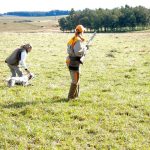New legislation is a big deal for hunters and others who love the outdoors.
Photo above by Vic Schendel
On August 4, President Trump signed into law the Great American Outdoors Act. This legislation is being called one of the most important conservation initiatives since Theodore Roosevelt’s time, and the greatest commitment to increasing public access and conservation in a generation. It’s unusual to find legislation that is not only bipartisan but also overwhelmingly championed by groups as diverse as Safari Club International, Backcountry Hunters and Anglers, the American Hiking Society, the National Governor’s Association, National Shooting Sports Foundation, Ducks Unlimited, Boone and Crockett Club, and many others.
The new law does two major things: One, it provides full, dedicated funding for the Land and Water Conservation Act (LWCF) starting in FY 2021. Two, it allocates funding to remedy maintenance backlogs on public lands, including national parks, national forests, and BLM lands.
An article in The Hill prior to its passage put it this way: “Big picture, passage of the Great American Outdoors Act would fund countless shovel-ready projects all over the United States, such as repairing roads, trails, bridges and water structures, that would sustain important habitat, increase public access opportunities and get people back to work. This work would bolster America’s robust $778 billion outdoor recreation economy, the source of jobs and a contributor to healthy communities throughout the nation. Countless reasons to support the bill exist, including its diverse appeal across the political spectrum.”
The Land and Water Conservation Act (LWCF), although not well known to the general public, is one of the most important funding mechanisms for public lands and parks all over the country. LWCF was created in 1965. It dedicates a small portion of the royalties produced by oil and gas production on the Outer Continental Shelf for conservation and recreation purposes. It uses no taxpayer dollars. Over its 52-year history, LWCF has contributed some $16 billion for lands and parks in all 50 states, making it the nation’s most important conservation and recreation funding source. Not only have LWCF funds helped purchase large chunks of public land, they have paid for baseball fields, playgrounds, and swimming pools in small towns and inner cities; the idea was to ensure that all Americans would have access to outdoor spaces and recreation.
The LWCF had one problem: It was originally supposed to distribute $900 million a year to states for conservation and recreation funding, but it’s only met that goal twice in its 52-year history. The rest of the time, some of its funds have been sneakily diverted by Congress for other purposes. Thanks to the Great American Outdoors Act, that shouldn’t happen again. The legislation makes the $900 million from the LWCF fund off-limits to those who want to get their hands on it—something that conservation groups of all stripes have been trying to accomplish for years.
The maintenance backlog segment of the Great American Outdoors Act is another much-needed piece of the outdoor recreation puzzle, as anyone who has warily approached a crumbling restroom in a forest service campground can attest. This will provide $9.5 billion over five years, with 70 percent allocated to the National Park Service and 15 percent for the U.S. Forest Service. The remainder of that money will be split equally between the U.S. Fish & Wildlife Service, the Bureau of Land Management, and the Bureau of Indian Education.











